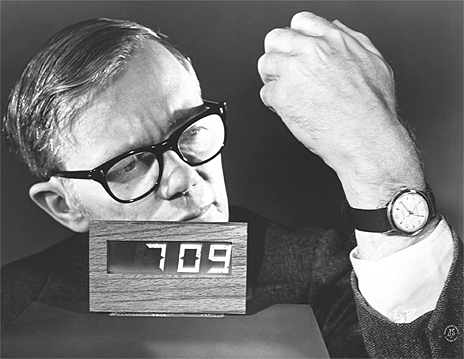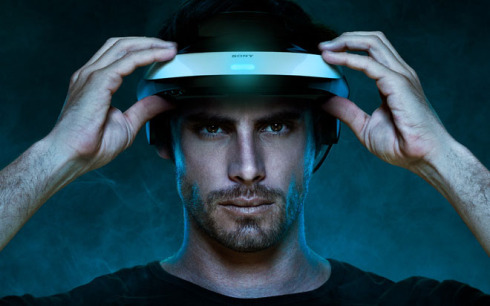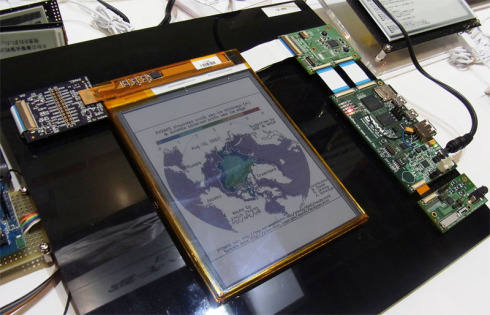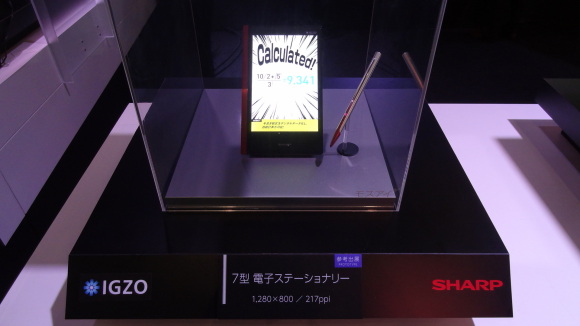Display Technology News Roundup 4.15.2013

Image via Tony Law for Bloomberg Businessweek
How Samsung Became the World's No. 1 Smartphone Maker "Lee Keon Hyok predicts that smartphones will indeed become commoditized, just as PCs did in the 1990s. “But you have to remember, we make a lot of parts,” he says. “The shape may change, but phones are still going to require AMOLED displays, memory, and processors. We are well prepared to meet those changes.” AMOLED refers to active-matrix organic light-emitting diodes. It’s the state of the art and possibly the only display technology that has its own K-pop song: Amoled, a catchy 2009 number by Son Dam-bi and After School. When the mobile business ceases to be profitable, Samsung will have to force its way into some other industry that requires a lot of upfront capital and expertise in mass-manufacturing. The company announced in late 2011 that it would spend $20 billion by 2020 to develop proficiencies in medical devices, solar panels, LED lighting, biotech, and batteries for electric cars. And if Samsung batteries or MRI machines don’t take over the market, maybe the chairman will set a huge pile of them on fire. “The chairman is saying all the time, ‘This is perpetual crisis,’ ” says mobile marketing chief DJ Lee. “We are in danger. We are in jeopardy.”" via Bloomberg Businessweek
Next-Gen iPad To Be Lighter, Thinner Thanks To New Display "“It’s likely that part of the thinner/lighter design will be reducing the size of the LED backlight, partly by making the display more efficient and partly by using more efficient LEDs,” NPD DisplaySearch analyst Paul Semenza told CNET in a recent note. ”The other significant change that we feel is likely is a shift to a film-based touch sensor.” ...Apple may unveil its next-generation iPad during a special press conference later this month, though a recent rumor suggested that the new tablet won’t launch until fall 2013." via BGR
Nvidia shows off stunning graphics with Kepler Mobile chip "Nvidia chief executive Jen-Hsun Huang showed off the company’s next-generation mobile chip, dubbed Kepler Mobile. Speaking today at the company’s investor day, Huang said that Nvidia made a huge investment in transforming its high-end Kepler family of PC desktop graphics chips so they can run on mobile devices. ...The new chip will be able to play high-end PC games such as Battlefield 3, pictured in the video below. That means that Kepler Mobile could enable mobile devices — smartphones and tablets — to run DirectX 11 graphics, with high-end features such as advanced shadows and lighting. To date, this hasn’t been possible — by a long shot — on mobile devices." via VentureBeat
What’s New in Multi Touch Technology? "By offering a more complete picture of how modern multi-touch technology is impacting business, the more we can better understand the environmental, ergonomic, economic and workflow enhancements that are resulting from innovations of this technology. This paper focuses specifically on new and existing users of equipment in the fields of building automation and HVAC, medical & healthcare, interactive and self-service kiosks. Moreover, it evaluates the most current technologies, features and benefits of multi-touch technology." via AIS
Pixelligent Technologies launches PixClear Zirconia nanocrystals for increased light output in touchscreens "When incorporated into existing products, the nanoadditives can dramatically increase light output and readability of modern touch screens and displays. PixClear, Pixelligent officials say, also increases the light output of products for lighting applications such as HB-LEDs and OLEDs. Prior to Pixelligent, nanocrystal dispersions suffered from aggregation and were cloudy, difficult to process, and unstable, which prevented their commercial adoption. But Pixelligent officials claim their PixClear dispersions are something new: they're perfectly clear. These clear dispersions allow Pixelligent to deliver precise control over the target applications’ optical, chemical and mechanical properties." via Solid State Technology
Planar Releases 3D BIM Models of LCD Displays and Video Walls through Autodesk Seek "Digital display company Planar Systems Inc. has announced that 3D Building Information Modeling (BIM) models of select Planar large format LCD displays and video walls are now available free through the Autodesk Seek web service. Autodesk Seek allows architects, engineers and designers to easily find, preview and download 3D models of Planar displays. They can then incorporate these models into their building plans without having to create the models themselves." via Digital Signage Connection
Touchscreen Gestures Reimagined as Sculptures "In an era when kids become intimately familiar with tablet and smartphone devices at a young age, designer Gabriele Meldaikyte captured today's touchscreen gestures in analog form. As shown in the video above, Meldaikyte's mixed-media exhibit reimagines the language of smartphone communication as sculptures; there's pinching, tapping, scrolling, flicking and swiping. ...Although touchscreen gestures are common today, there could be a shift towards more intuitive ways of control such as voice command (e.g. Google's Project Glass)." via Mashable
Display database for engineers Search thousands of display panels by multiple characteristics and compare results side-by-side using the display database multisearch.
Convergent screens, content and data creating 'One Screen' to rule them all "Today the consumer disposition changes based on two things: where they are and what they are doing. For instance, a personal screen (tablet, mobile) or the screen on the wall becomes a point of wait whenever the consumer has "Dwell Time." They could be in line getting coffee or at a doctor's office. When the consumer is driving down the road, or at a train station or airport, the consumer is "On the Go," and their screen or the screen in the venue or on the roadside becomes a point-of-transit screen, where the messages are brief and about the brand. And when the consumer is either in a retail environment or just sees something they want to buy, the screen then becomes a point of sale, where the consumer is now a "Shopper."" via Digital Signage Today
China panel makers continue to improve their panel technology "China-based panel makers BOE, Tianma Micro-electronics and China Star Optoelectronics Technology (CSOT) are showing increasing signs of improved technology and are likely to start producing more high-end panel products in 2013. The panel makers currently use a-Si TFT technology to produce Ultra HD (3840 by 2160) TV panels but are looking into using IGZO technology in 2013 instead. The makers are also aiming to release 400ppi smartphone panels during the year." via DigiTimes
Computing Pioneer Alan Kay Talks About The Past, Present, and Future of User Interfaces "Part of the motivation for the PARC GUI came from our desire to have a universal display screen which could display anything — this led to the bitmap screen. One drawback of these screens and the screens today is that the visual angle of the display (about 40°) is much narrower than the human visual field (which is about 135° vertically and 160° horizontally for each eye). This is critical because most of the acuity of an eye is in the fovea (~1-2°) but the rest of the retina has some acuity and is very responsive to changes (which cause the eye to swing to bring the fovea on the change). Head mounted displays can have extremely wide fields of view, and when these appear (they will resemble lightweight glasses), they will allow a rather different notion of UI — note that huge fields of view through glasses will help both 2-1/2 D and 3D graphics, and the UIs that go along with them. This suggests many new design ideas for future GUIs, and they will slowly happen." via Time
Novel Plastic Film Displays Glasses-Free 3-D Images For Mobile "The film is basically a lenticular lens, which is a series of tiny lens elements that direct light to each eye. The nanoimprinting technology developed at IMRE makes it possible to create this type of lens on a plastic film. “The filter is essentially a piece of plastic film with about half a million perfectly shaped lenses engineered onto its surface using IMRE’s proprietary nanoimprinting technology,” said Jaslyn Law, the IMRE scientist who worked with TP on the nanoimprinting R&D since 2010, in a press release." via IEEE Spectrum
Quantum Dots in LCD Before OLED "As you read this, retailers are putting Sony model W009A BRAVIA TV sets on shelves around the USA. We’ll be seeing quantum dots in LCD before OLED for sure. It didn’t look that way a few years back, so I thought it would be interesting to bring us all up-to-date on the industrial and commercial development of quantum dot (QD) technology for display applications. ...Given the extent of industrial development, I expect to see more results soon. OLED TV has not progressed as fast as hoped and LCD makers need extra features to justify UHD prices. This looks like the right time for LCD color gamut to become a key product feature and reason for consumer upgrades." via Display Central
Interactive Holographic Video Display "Holoxica announces an Interactive Holographic 3D Display, which is a second generation prototype. The design is inspired by Head-Up Displays (HUDs), based on free-space optics with images floating in mid-air that can change in real-time. ...The interactive holographic display system comprises a Holographic Optical Element (HOE) lens, a digital controller, a motion sensor and a projection subsystem (a laser projector) imaging a diffusion screen. The HOE is about the size of a page (20x30cm) and the images are formed in real space (in mid-air) about 20cm from the hologram plane. The image are about the size of a hand (up to 7x7cm). The images can be refreshed at video rates and arbitrary images can be displayed. However, the images are formed in three distinct planes, corresponding to the colours of the lasers in the laser projector i.e. red, green and blue. ...Immediate applications of this technology include HUD-style displays and novel user-interfaces with the added dimensions of real-space interactivity. " via Holoaxica
Do you have content to share with Display Alliance? Anyone can post press releases, white papers, commentary, videos, and more in the open section.
An introduction to CPI's OLED prototype line facility "The Centre for Process Innovation (CPI) is a UK based R&D institute that helps companies develop and scale manufacturing processes. The CPI sent us the following video and update on its OLED/OPV prototype line (built by MBraun) that was designed to enable materials companies, device designers and end users to develop their technology within a fully automated, controlled environment. CPI's system supports both small evaporized and soluble OLED materials." via OLED-Info
LCD VS Plasma TVs "For those of you who care to understand the science behind [Plasma TVs], here’s how the magic happens: An electrode applies an electrical current to a small cell filled with a noble gas mixture (usually neon and xenon). This excites the gas, ionizing it and transforming it into a plasma. This plasma emits ultraviolet light – which we can’t see – but when the UV light hits a phosphor coating that lines each cell, it causes the phosphor to glow and put out light that we can see. Depending on which particular phosphor the cell is coated with, it will create a red, green, or blue glow. Just like with LCD displays, each cluster of red green and blue subpixels makes up one pixel on the screen (see header image)." via Digital Trends
QD Vision secures $20m to ramp production of components for LCD applications "According to the company, Color IQ significantly improves LCD color performance. Until now, most mainstream LCD TV designs have had to sacrifice color quality, typically only delivering 60-70 percent of the NTSC color standard. Color IQ increases typical LCD color performance by up to 50 percent and is capable of delivering 100 percent of the NTSC standard, QD Vision said." via Boston.com
George Gray, the man who made flat screens possible "Gray didn't invent liquid crystals. In fact, they are quite common; every cell in our body is surrounded by a liquid crystalline membrane. Nor did he demonstrate that liquid crystals have the flippable characteristic that makes them suitable for displays. Gray's breakthrough was to develop molecules that are flippable at room temperatures. But just like so many great innovations the road to development was far from easy largely because there was little appetite for funding research on molecules that, at the time, had no clear applications. Turning liquid crystals from curiosities into the ubiquitous technologies that they are today required both a burning need for new displays and the foresight of one of the more colourful government ministers." via The Guardian
Apple job listing confirms Apple is investigating using flexible displays in future products "Flexible display rumors have picked up steam even more since rumors of an iWatch from Apple, and just today we came across two new Apple patent applications detailing flexible devices that could change states as a user bends or twists the device. We all know Apple patent applications have never been a good indication of future product releases, but now Apple has came right out and stated in a job listing that it is indeed considering flexible displays. "Apple Inc. is looking for a Display Specialist to lead the investigation on emerging display technologies such as high optical efficiency LCD, AMOLED and flexible display to improve overall display optical performance."" via 9to5Mac
OLEDs and the beginning of the end for LCDs "In 2012 Samsung Electronics moved their LCD business units into a separate entity. One report suggests that the Taiwanese have invested $60 Billion in the LCD industry and seen a return of just $40 Billion. Some Japanese makers, despite having superb technology, have seen recent losses in some cases equal cumulative profits of the preceeding 5 to 10 years. Restructuring is therefore afoot. In the last few weeks Samsung purchased a 3% stake in Sharp. Japan Display Inc (JDI), puts together small and mid sized LCD panel manufacture units from Sony, Hitachi and Toshiba, focusing on automotive, cellphone and digital camera displays (not TV). Meanwhile, the Chinese are quickly moving into LCD panel production. For many years the top five in the LCD business, in order, were Samsung, LG Display, Innolux, AUO and Sharp. Now, as evidence of China's progress, in late 2012 Chinese BOE is number 5 for notebooks and monitors and China Star (CSOT) number five for TVs." via Printed Electronics World
Epson Concedes It Showed Reflective-LCD Projector Too Soon "The reflective LCD technology differed from conventional high-temperature polysilicon (HTPS) in that the polarized light rays don't pass through the panel but rather are reflected back at a different angle than they came in on. But the reflective technology also required a more complex polarized beam splitter to combine red, green and blue images and took semiconductor controllers out of the optical path and put them behind individual pixels." via Consumer Electronics Daily
Are you an engineer or have display expertise? Email jason@displayalliance.com to be featured in the interviews section.
Multi-focal AR contact lenses work for both near and far "The idea behind the iOptik, is that the contact focuses foreground light, like that from a nearby monitor, onto the center of the pupil. The background light is focused on the surrounding (annular) regions of the pupil. This resembles currently prescribed multi-focal contact lenses, which seem to work quite well — only these guys are just a little more extreme in the separation of the two fields. As shown in the video above, the image is projected directly onto display components that are integral to a pair of special glasses. Superimposing full-field 3D virtual images, which would be particularly enticing for the gaming world, would be seamless with such a device. Interaction with avatars would take place in the whole user space rather than just on a limited screen." via ExtremeTech
Japan Display has begun to see profits "Japan Display is a joint venture of Japan-based firms such as Sony, Toshiba and Hitachi with 70% of shares owned by government-affiliated institutes. Sony, Toshiba, and Hitachi each owns 10% of shares. Japan Display was established on April 1, 2012 with capital of JPY230 billion (US$2.3 billion) and currently employs around 6,200 staff. Otsuka noted that Japan Display focuses on LTPS-CMOS technology and expects panel capacity to increase to six million units in 2014 due to minimizing non-silicon based technology capacity and focus on expanding LTPS capacity." via DigiTimes
Displays defy distraction at New York Auto Show "At BMW, where analog instrument clusters are part of the classic BMW look, many of the high-tech electronic displays in 2014 models mimic analog dials. Even the BMW Concept Active Tourer premium compact car displayed at the show has a rounded albeit digital electronic instrument cluster. Here again the large display in the futuristic infotainment console isn’t a touchscreen. The only touchscreens are the two removable iPad-like displays facing the rear passenger seats, which also have access to handy fold-down trays." via TechHive
Smell-o-vision screens let you really smell the coffee "The "smelling screen", invented by Haruka Matsukura at Tokyo University of Agriculture and Technology in Japan and colleagues, makes smells appear to come from the exact spot on any LCD screen that is displaying the image of a cup of coffee, for example. It works by continuously feeding odours from vaporising gel pellets into four air streams, one in each corner of the screen. These air streams are blown out parallel to the screen's surface by fans, and varying the strength and direction of them manoeuvres the scent to any given spot on the screen." via NewScientist
Bendable screens still need a breakthrough ""There are barrier films in all sorts of products, for example food packaging, but the challenge is that OLED is one of the most sensitive materials we follow, and so creates huge challenges," says Lux Research's Melnick. Singapore-based Tera-Barrier Films, for example, has developed a way to plug leaks in the layers using nanoparticles. Director Senthil Ramadas says that after years of delays the company last month started production in Japan and aims for mass production by end-2014. "You have several challenges in the value chain," he said. "All these things need to be established, and only now is it coming out." And there's another problem: all the materials in a bendable display need to be bendable, too — including the transparent conductors that drive current through the display. Several technologies are vying to replace the brittle and expensive Indium Tin Oxide (ITO) used in most fixed displays, including nanowires, carbon nanotubes, graphene and conductive mesh." via NBCNews
Is Samsung safe from the threat of Korean war? "Samsung's primary hedge against the threat of war remains its massive geographic diversification of manufacturing assets, experts note. While Crystal Valley, a two million sq ft complex built on a former vineyard that employs about 20,000 workers, is an important cog in the Samsung machine, particularly in LCD display manufacturing, it's just a small part of the company's global capabilities. The company boasts five other plants worldwide that could pick of the display manufacturing slack in the event of a global shutdown."via Channelweb
Three-dimensional displays, past and present "The ultimate goal of display technology is to show a dynamic three-dimensional image that appears to float without a frame, much as Princess Leia did when projected from R2-D2 in the 1977 movie Star Wars. The history of 3D displays begins in a much earlier time—long before the advent of movies, holography, or electronics. It goes back to 1838 when Charles Wheatstone at King’s College London proposed the concept of the stereoscope, which works based on binocular disparity: Because our two eyes, physically separated by about six and a half centimeters, observe different perspectives of an object, the illusion of depth can be created from two 2D images whose features are slightly offset from each other. The brain merges those two images into a single 3D perspective." via Physics Today
Laser Fusion’s Brightest Hope "Here at the Lawrence Livermore National Laboratory, a U.S. national security laboratory tucked amid vineyards and undulating grassy hills about an hour east of San Francisco, the lasers of the National Ignition Facility (NIF) have already created the intense pressures and temperatures needed to get atoms of hydrogen to fuse. But NIF is trying to achieve a far more challenging goal, one that countless researchers have sought for decades. NIF’s aim is not just fusion but fusion’s equivalent of a chain reaction, a self-sustaining “burn” capable of producing more energy than is needed to get the process started in the first place. ...The laboratory has also built a small industry around damage mitigation. After a laser shot, engineers can use a telescope in the target chamber to look back through every line of optics for damage; each defect gets a number. They then use blue LEDs to program liquid-crystal-based screens through which beams pass before amplification. These screens can be made to have any arbitrary pattern of transparent and opaque areas, creating dark spots in a beam in order to circumvent damaged areas down the line. When too many defects accumulate, the engineers remove the damaged component and send it to another building, where the surface is re-treated and carbon dioxide lasers are used to etch out damage, leaving behind optically neutral conical pits. Nowadays, up to 40 pieces of optics, mostly the target-chamber focus lenses and debris shields—protective screens between the target chamber and the rest of the optical line—are pulled and sent away to be refurbished each week." via IEEE Spectrum
What did you think about today's news? Leave a comment here and share your thoughts.
 Display Alliance
Display Alliance


